Next Generation Preschool's Grazi Murad Imparts Love of Science, Animals to Students
January 30, 2017
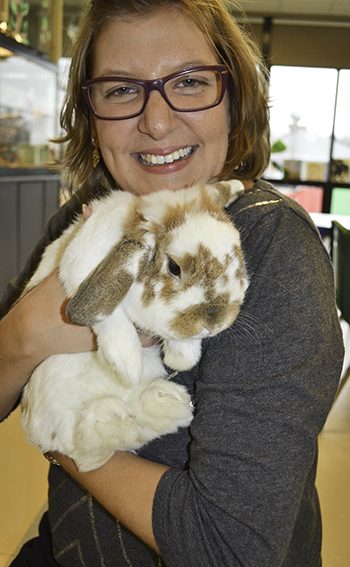
NGS Pre-school Science Teacher Grazi Murad with Gizmo the Bunny.
Practically the first thing one sees upon entering Next Generation School’s Preschool is an intriguing, glass-enclosed structure—science teacher Grazi Murad’s classroom. When one ventures into the room, replete with exhibits, butterfly-filled cases, and animals in enclosures that simulate the different habitats the animals are from, her love of animals—and her students—is quite apparent. That her students love her and her hands-on style of teaching science is also readily apparent. The kids not only get to look at and hear about the eclectic range of animal friends in Murad’s menagerie, they get to meet them face to face—animals like Lizzy the Leopard Gecko, Gizmo the Bunny, Arnaldo the Chinese Water Dragon, and Bridget the Fire Corn Snake. They even get to touch them…if they’re brave enough.
For Murad, who is a biologist, teaching science to Next Generation’s preschoolers is a perfect fit. “I just love animals. And I love kids. And I think the interaction between animals and kids is great…I tell them what the animal has, what they do, what they don’t do. They learn. They’re so curious. This is what I love about that age. They’re curious, and they love everything you bring.”
According to Murad, the kids do well when touching the fragile creatures: “The kids are really careful, and they control their bodies and their behavior, and they’re gentle. It’s so beautiful when they’re interested.” And on the cold Tuesday morning in January that this reporter visited the classroom, the youngsters were very interested and engaged…and gentle.
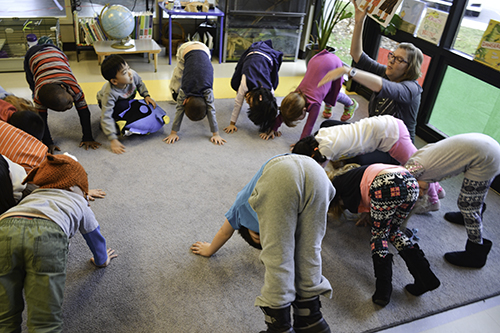
Murad's preschool students arch their backs like the cat in the book she's reading about animals' unique characteristics.
Murad began her class with a routine no doubt designed to give her young charges a chance to work off some of their excess energy and to settle down. They began class by doing some welcome-to-science-class stretching exercises, and singing a song, followed by an interactive session reading a book about different animals.
Murad says she visits the local library every week to get new material—apparent by the selection of books about animals that line her window shelf. The day this reporter visited, she read the children From Head to Toe, a book about a number of different animals, some of their unique features, and some of the different ways they move their bodies, which the kids then tried to emulate with their own bodies—perfect for preschoolers.
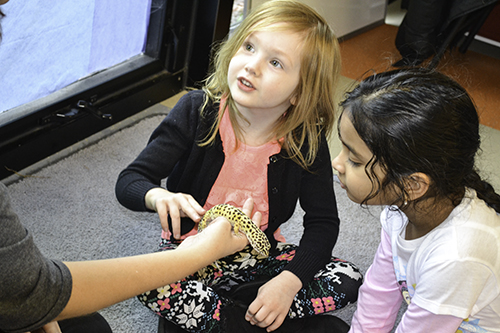
One of Murad's preschool students pets Lizzy the Leopard Gecko, the animal of the day.
Then it was time to introduce the youngsters to the animal to be spotlighted for the day’s lesson: Lizzy the Leopard Gecko. And to ensure that the children remained gentle once she got Lizzy from her enclosure, Murad had the kids review their animal-time etiquette—a set of classroom protocols which she had put into place to ensure that the animals don’t get injured. First, she had her students sit and cross their legs (so the creature wouldn’t inadvertently get kicked or stepped on) and keep their hands in their laps until it was their turn to touch. She also went over the touching protocols. Regarding their up-close-and-personal interactions with the animal, they weren’t to touch the its head, lest they injure it, and were only allowed to pet the animal in a downward motion on its back because of its scales.
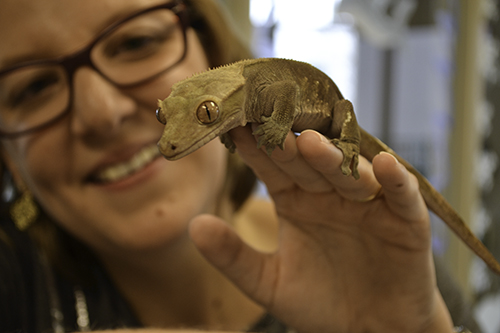
Murad shows off one of her unique animals, Juan the Crested Ghecko from the forest in New Caledonia, Australia.
Murad indicates that the science lessons she teaches the students tend to be based on their interests.
“I’m always searching for new things to bring to the kids, and I love hands on. I came from a Montessori background, and I just love the whole, 'They can do it. They build their own materials. They build their own experiments.'”
So when she arrived to teach at the school in August of 2016, and the kids wanted to know about the animals she had brought, she decided, “Hey, let’s start with the habitats of the world, because we have animals from all habitats in here. So let’s do that, because the kids, they want to know. They want to learn about those animals. So let’s learn about those animals because they want to.”
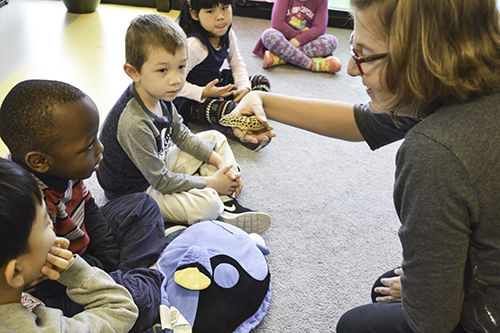
Some preschoolers interact with Lizzy the Leopard Gecko.
During their study of habitats, they learned about animals that can live in those habitats and, according to Murad, "We focused on their body's adaptations to live in those interesting and sometimes extreme habitats."
She discusses what the animals eat and drink, whether or not they swim, if they breathe air, or they breathe air in the water. “They just start asking questions. I kind of follow the kids’ questions. It’s simple. It’s beautiful. They’re so interested in it,” Murad exclaims.
So every month since she arrived, they’ve learned about a different habitat. The first month was the forest. “Then we talked about the forest, and the animals that live in the forest, and we talked about what they need to survive,” she explains. In October, the habitat they learned about was the dessert, followed by oceans and rivers in November, and (extremely apropos for December, with Santa preparing for his journey from the North Pole) the polar habitats. In the Spring 2017 semester, they'll address some themes other than habitats: the Human Body (Feb), Insects and Bugs (March) and, just in time for spring, Plants, Flowers, and Seeds (April).
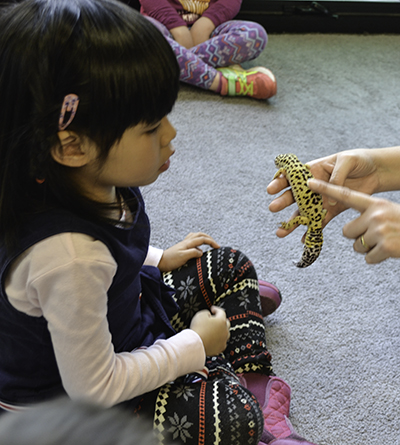
A preschooler gets an upclose look at Lizzy the Leopard Gecko.
The Pre-School director, Chris Brooks, is excited about Grazi's methods, and calls her "an amazing teacher. She is engaging and shows children how fun science can be. She allows them to learn at their own pace and raise questions to engage their sense of wonder. She truly understands how children’s everyday experiences are the foundation for science and takes these experiences and creates fun, hands-on experiments for them to grow and learn from.
Brooks philosophy regarding science instruction echoes what Murad is doing in her classroom: "Our desire is for the science instruction to inspire creativity, ingenuity, and a love of the sciences. Students learn best when they can see, smell, feel and experience science first hand. At our preschool, we have a unique opportunity to engage our little ones, who are already naturally curious, in a wide variety of scientific concepts. This helps students to understand not only science content, but also scientific processes. We want our student to continue to develop their natural inquisitiveness and also know that it’s acceptable to explore and to question the things in their world."
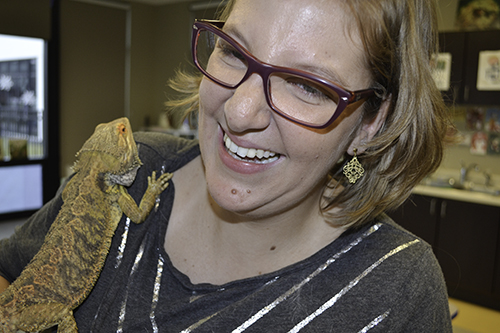
Murad spends some up-close-and-personal time with Gordon the Bearded Dragon who lives in the dessert habitat.
Brooks shares a few anecdotes about how the kids’ love of and understanding of science has been enriched: "Though the students love everything about science, a definite favorite is the animals. Each night, the children walk by the science room and wave good night to Ms. Grazi, and to each animal. Many students even go into the science room before leaving for the night to give the animals a “hug.”
In fact, Brooks has learned a few things from the kids herself! "I love hearing the stories and information that the students learn in science. Many of our students will come back from science and teach me about what they learned about. One of my favorites—“Did you know that some animals have a an extra layer of fat on their bodies and it helps keep them warm. That must be why my grandma is always so warm!”
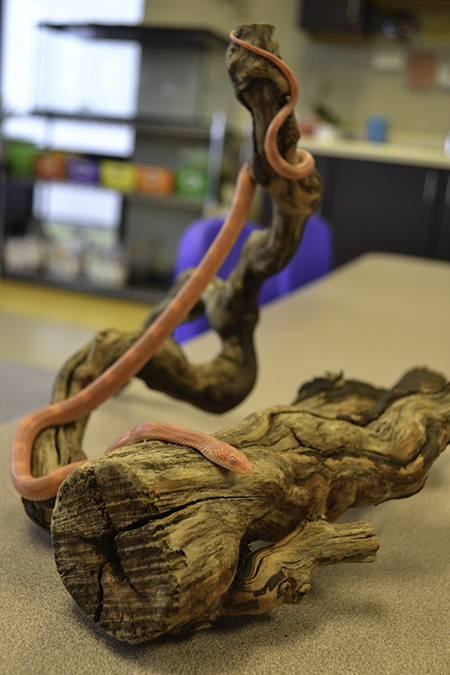
Bridget the Fire Corn Snake, whose habitat is the dessert of the southeastern United States.
And, since hands-on seems to be one of the chief ways of learning in Murad’s classroom, once class was over, this reporter got to meet and touch (and photograph) the animals herself. (Not enamored with snakes, in general, I even drummed up the courage to touch Bridget the Fire Corn Snake. After all, how ashamed would I have been if 4-year-olds had been brave enough to touch the snake, but I wasn’t?)
Regarding touching the different animals, Murad explains, “I think it’s good for the kids. They’re not scared,” then qualified her statement with, “Sometimes they are, and it’s ok. They deal with their feelings and we talk.”
She also enjoys collaborating with the other preschool teachers. “I love big projects, joining the other teachers. I love being here and doing everything with the kids and just go with their interests”
Does she see any future scientists among her flock? “Oh yes!” she says, then admits that they’re even thinking about the class when they’re away from it. “They love the animals. Sometimes they find insects during the weekend and parents have to save them so they can bring it to me,” she says.
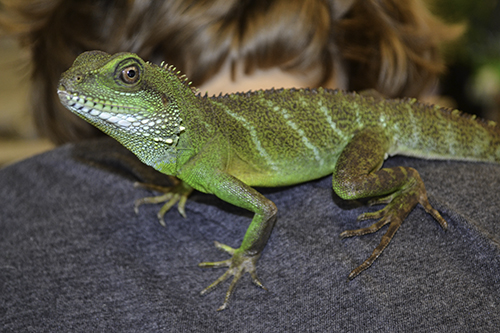
Itching a ride on Murad's back is Arnaldo the Chinese Water Dragon whose habitat is the forests of southern China and southeastern Asia.
And she’s quite proud of her collection of “show- and-tell” treasures the kids have brought in to her, which she keeps in a special box: coral, a seahorse, a shell, insects, a ghecko egg. Her little box even contained a couple of Bridget the Fire Corn Snake’s old snakeskins that she had shed.
And to get them in the mindset of thinking that they can be scientists, Murad is constantly encouraging the children that science is a viable career field and that they can become scientists by liberally sprinkleing throughout her teaching the word "scientist." Fir instance, she addresses them as scientists, and commends them when they’re displaying the characteristics of good scientists.
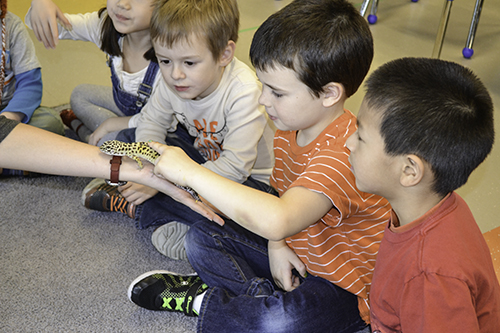
Murad's preschoolers get a chance to pet Lizzy the Leopard Gecko.
“I love when their eyes shine about a story or an animal I can bring,” she admits, “It’s special. I love every day that I’m here with the kids.”
More: PreK-6 Outreach, Next Generation School, Science Fair, 2017
For additional I-STEM articles highlighting Next Generation School activities, see the following:
- 2015 NGS Science & Engineering Fair Called the "Most Successful" Ever
- Next Generation School's Science and Engineering Fair: Every Student Is a Winner
- Next Generation School Fair: Tomorrow's Scientists & Engineers Meet Today's
- Local Teacher Uses Project Lead the Way to Prepare Next Generation of Engineers
- MechSE Gives Back to the Community

One of Murad's tree frogs.

Murad interacts with Bambi the Guinea Pig.
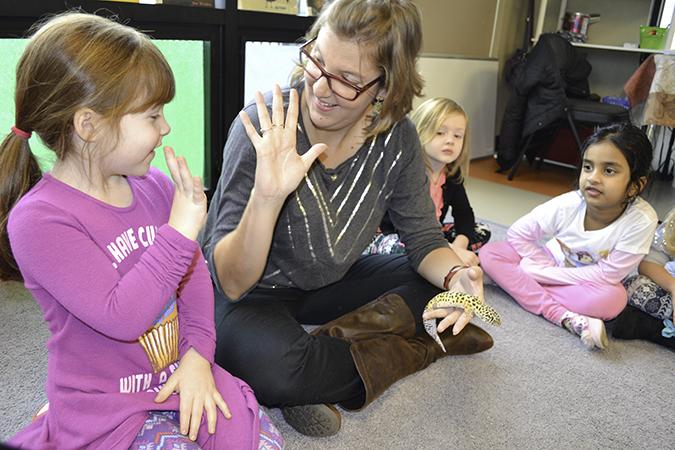
Grazi Murad (center) interacts with a preschooler during her science class.
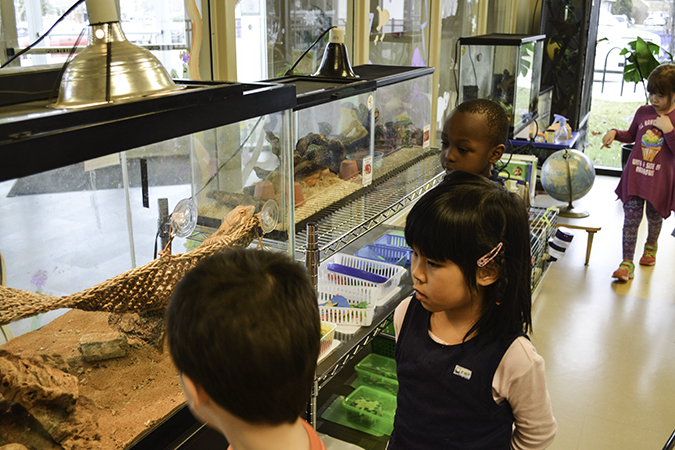
Preschool students check out the different animals in Murad's menagerie on their way to line up.













.jpg)
















